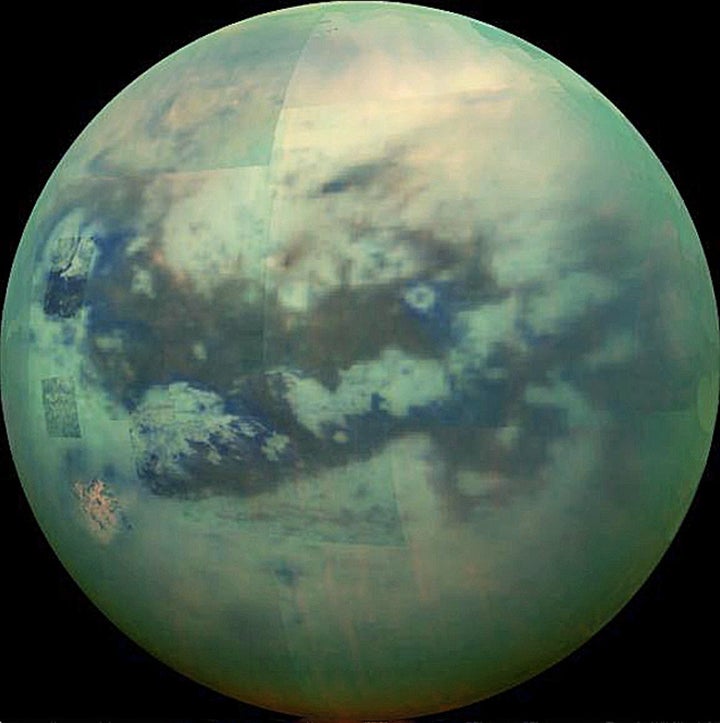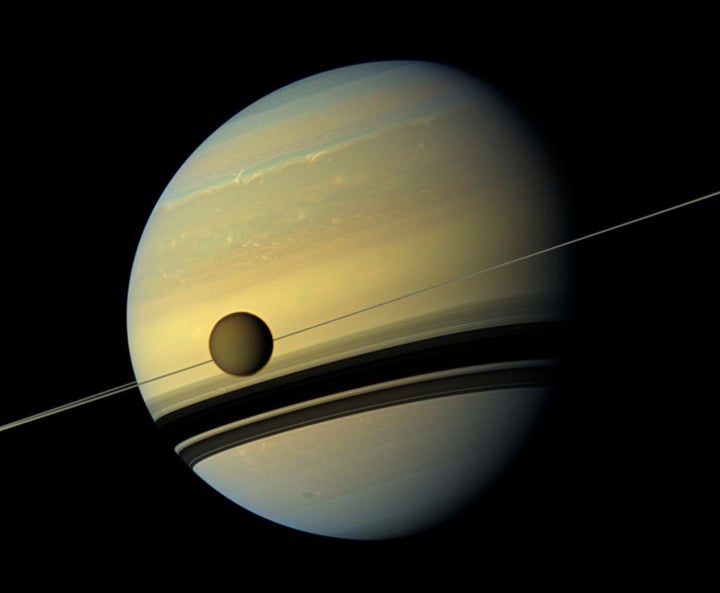
Of the 173 known moons orbiting the eight major planets of our solar system, only one ― Saturn’s Titan ― has an atmosphere, lakes and streams.
And that’s not all. There’s also speculation that Titan ― half the size of Earth ― could harbor life forms or be a possible future home for Earthlings. The provocative moon was even featured in Kurt Vonnegut’s 1959 novel The Sirens of Titan, which tells the story of a millionaire on a quest for the ultimate meaning of existence.
To study this remarkable moon, NASA launched its Cassini spacecraft in 1997. After maneuvering through the asteroid belt between Mars and Jupiter, Cassini finally arrived at the Saturnian system in 2004. It found liquid methane lakes and seas replenished by rain from hydrocarbon clouds, as well as evidence that Titan is home to a giant internal ocean.
But despite the abundance of images and data Cassini has accumulated thus far, it will soon stop transmitting information back to Earth. Next September, the spacecraft will begin its final mission: a death plunge through the gap that separates the rings of Saturn from the planet.
“Cassini will be directed in its last six months into a series of orbits that go very close to Saturn’s atmosphere,” said Jonathan Lunine, director of the Cornell University Center for Astrophysics and Planetary Science and a Cassini mission team member. “The spacecraft’s orbit will be deflected by a final flyby of Titan. Then, it actually enters Saturn’s atmosphere and burns up.”

Lunine said there was a good reason Cassini’s mission is coming to such a fiery end. “We don’t want a derelict spacecraft flying around the Saturn system on the off chance that there might be microbes on the spacecraft. It’s what’s called planetary protection,” he explained. “Before the last of the fuel is exhausted, we want to make sure Cassini is destroyed. It’s a very definitive end to the mission, but it’s the right thing to do.”
It also means that after Cassini’s planned demise, there won’t be any immediate, on-location attention paid to Titan to determine just how Earth-like it may actually be.
Fortunately, the spacecraft has already transmitted a huge amount of data back to Earth for scientists to pore over, and they’ve already learned some remarkable things.
“Until the Cassini mission, little was known about Saturn’s largest moon Titan, save that it was a Mercury-sized world whose surface was veiled beneath a thick, nitrogen-rich atmosphere,” reads a NASA-Jet Propulsion Laboratory report. “But Cassini mapped Titan’s surface, studied its atmospheric reaction, discovered liquid seas there and even sent a probe to the moon’s surface, completely rewriting our understanding of this remarkably Earth-like world.”
Hoping to get as close as possible to Titan’s surface in 2005, NASA scientists instructed the European Space Agency’s Huygens probe to detach from Cassini and head down for the first landing on the surface of a planet or moon in the outer solar system, as depicted in the following video of Huygens’ descent.
“Every object in the solar system seems to be unique, but Titan is especially so, because it’s the one natural satellite of another planet that has a dense atmosphere,” Lunine told The Huffington Post. “A few others have thin atmospheres, but this is an atmosphere that’s dense enough that you could parachute to the surface, and that’s exactly what Huygens did.”
“Everything that Cassini and its probe Huygens have shown us is that this is an active cycle of weather and of formation of streams and rivers, which really makes this moon different from all the other moons in the solar system,” he added. “Cassini and Huygens told us that Titan is a place with an active climate system. There are large seas and hundreds of smaller lakes containing liquid methane and other organics in the polar regions of Titan ― enough liquid methane to be the equivalent of more than 200 times the known oil and gas reserves on Earth.”
Titan is not exactly Earthling-friendly, however, given the extreme methane conditions and an average temperature of minus 290 degrees Fahrenheit. And after more than 30 years of research into Titan’s unique environment, Lunine warns that there is “a real boundary in the solar system” that should also discourage Earthlings from making Titan our second home.
“Once you go beyond Mars, in order to get to other objects, like the moons of Jupiter or Saturn, you’re spending so much time in space, as an astronaut, that you’re absorbing a lot of radiation, particularly cosmic rays, which are very difficult to shield against,” he explained.
With the news earlier this year of the discovery of “Proxima b,” a potentially Earth-like planet just over four light-years away from us, it would be ironic if one of the moons in our own solar system turned out to have many of the same characteristics as our home world.
Yet with Cassini’s planned 2017 death dive into Saturn, it will be many years before another mission is sent to Titan to make further and possibly more tantalizing discoveries.
This long-term waiting, while frustrating, also gives scientists like Lunine hope for the future of space exploration ― and serves as important motivation.
“As far as ensuring our own continued survival, we have to do that by taking care of our home planet,” he said.
“If we do discover that one of the moons of the outer solar system has life today ― microbial life ― or if there’s evidence discovered on Mars that life did exist there in the past, that would generate so much excitement that we would have discovered life that had a separate origin from life on Earth, it would compel a more ambitious exploration program.”

